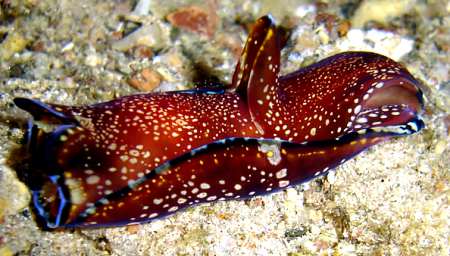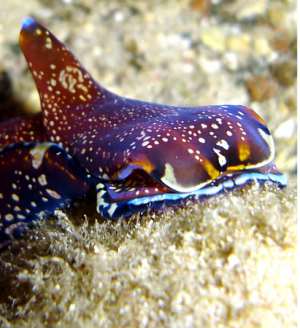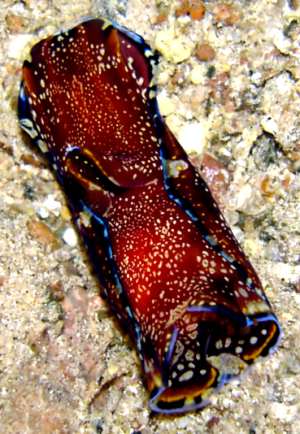Philinopsis depicta? from the Red Sea
April 14, 2005
From: Binyamin Koretz

Hi Bill,
Philinopsis cyanea appears in Eilat in the spring (roughly March-June) and we've never seen one bigger than 1.5 cm. This month (March) alone, we've seen 3 different specimens - all of them 1-1.5 cm in length and brown to black. Now we've encountered this robust individual, which we measured at about 8 cm when fully extended. Not only is the size out of proportion in light of the seasonality and the fact of its co-generationists being one-sixth the size, but also the reddish base color and the relative height of the top of the headshield don't fit the P. cyanea mold. In fact, it's remarkably similar to the 1998 Italian photo by Gianni Neto on your P. depicta Fact sheet, down to the irridescent blue tone in the red base color.
Locality: Eilat, Village Beach. Israel, Red Sea (Gulf of Eilat). Depth: 4 m. Length: ca. 8 cm. 26 March 2005. rubble slope, night. Photographer: Binyamin and Shulamit Koretz.Playing amateur scientist, we came up with 3 possible explanation
-
(our favorite) This is P. depicta, and it can now be considered a reverse Lessepsian migrant.
-
This is P. cyanea, but then, as you suggested elsewhere in the Forum, P. depicta and P. cyanea would have to be the same species.
-
(least likely) There are 2 different species with overlapping ranges, but one is small and brownish-black, and the other is large and tends to reddish.
What do you think?
Best regards,
Binyamin
binyamin@koretz.net


Dear Binyamin,
You raise a number of interesting points, including whether there are any examples of Mediterranean to Red Sea migration.
Concerning the identity of your animal. As you mention, I have difficulty in separating Philinopsis depicta and P. cyanea, apart from their geographic distribution. Their anatomy appears to be the same and they have the same very variable colour range. Concerning the 'the relative height of the top of the headshield' of your individual, and its large size, have a look at the animals from Zanzibar and Dar es Salaam I have on the P. cyanea Fact Sheet, showing an equally large 'horn' on the posterior head shield and animals growing to 7 cm in length.
Size is quite an interesting characteristic in aglajids. I have found species such as Chelidonura inornata and C. fulvipunctata in huge numbers, mating and laying fertile eggs in Sydney, but growing to no more than 15 mm long, while in tropical waters they grow to twice or three times that length. I am not sure if food availability or environmental temperature affects their growth rate. Age certainly affects their size. Most cephalaspideans that have been studied, live for no more than a year, but a few individuals in a population appear to 'over winter' and so can live for at least 2 years. As they continue to grow, they can become relative giants. I suspect the large animal you have found is one of these.
At this stage I would say it is P. cyanea. The bluish tinge you note is found in most aglajids - certainly in those with darker colours and is a 'structural' colour caused by the way light is reflected and refracted off the constantly beating microscopic cilia that cover the skin of these animals.
Best wishes,
Bill Rudman
Related messages
-
What is Philinopsis cyanea doing?
From: Valda Fraser, August 6, 2008 -
Dark colour form of Philinopsis cyanea
From: Hugues Flodrops, August 5, 2008 -
Philinopsis cyanea from Reunion Island
From: Hugues Flodrops, February 18, 2008 -
Philinopsis taronga? from Reunion Island
From: Hugues Flodrops, February 18, 2008 -
Philinopsis cyanea from Perth
From: Brent Murdoch, January 17, 2007 -
Philinopsis cyanea? from Taiwan
From: Ching-Yao Chan, May 17, 2006 -
Philinopsis cyanea? from Victoria, Australia
From: Trevor McMurrich, March 24, 2006 -
Re: Aggregation of Stylocheilus striatus in Indonesia [1]
From: Paul Whitehead, January 23, 2006 -
Philinopsis gardineri? from Reunion Island
From: Philibert Bidgrain, December 13, 2005 -
Re: Philinopsis cyanea mating in Reunion Island
From: Francis & Pirjo Pellet, November 25, 2005 -
Philinopsis cyanea spawning at Reunion Island
From: Philibert Bidgrain, November 25, 2005 -
Two big Philinopsis cyanea mating in Reunion Island
From: Philibert Bidgrain, November 23, 2005 -
More colour forms of Philinopsis cyanea
From: Dong Bum Koh, June 13, 2005 -
Philinopsis cyanea ... eating?
From: Binyamin Koretz, April 28, 2005 -
Philinopsis cyanea from South Korea
From: Dong Bum Koh, April 14, 2005 -
Philinopsis cyanea? from Indonesia
From: Francis & Pirjo Pellet, January 13, 2004 -
Philinopsis cyanea from Port Stephens
From: Leanne&David Atkinson, May 13, 2003 -
Philinopsis cyanea & possible egg mass
From: Leanne Atkinson, May 9, 2003 -
Philinopsis cyanea from Lembeh Strait
From: Mary Jane Adams , February 6, 2003 -
Philinopsis cyanea from Lizard Is
From: Nils Anthes, February 3, 2003 -
Philinopsis cyanea from Lord Howe Island
From: W.B. Rudman, January 10, 2003 -
Philinopsis cyanea from Lord Howe Is.
From: Ian Hutton, December 6, 2002 -
Philinopsis mating from Korea
From: Dong Bum, Koh, June 17, 2002 -
Philinopsis cyanea from Sulawesi
From: Mary Jane Adams, May 4, 2002 -
Philinopsis cyanea mating
From: Julie Marshall, May 4, 2001 -
Philinopsis cyanea from New South Wales
From: Erik Schloegl, April 3, 2001 -
Philinopsis from Mauritius
From: Owen Griffiths, July 27, 1998
